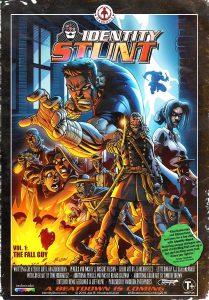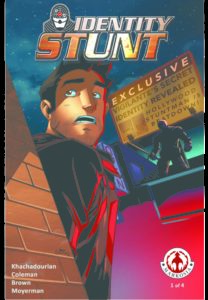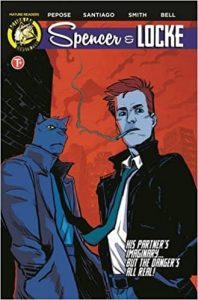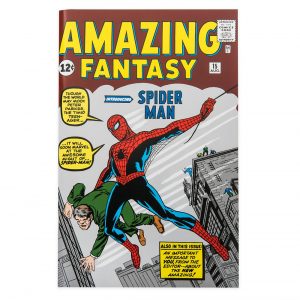
Regardless of where you live, what you do, or where you get your comics (because if you’ve found your way here and you’re reading this article, you’re a reader of comics), there’s no doubt that you’ve noticed some changes lately. Of course, the coronavirus has unleashed its special brand of chaos into our lives, but even before that there have been waves of change washing through the comic book industry. In all areas, whether you’re a fan of the Big Two (you know their names) publishers or a die hard supporter of the independent press, we can’t ignore that change has been coming.
ThePullbox has always focused on the smaller indie-press comics out there, and it’s from that perspective that a recent conversation started up. There’s no denying that the world as a whole is in a little bit of flux right now. Likewise, the comic book world has been seeing some changes, a process kicked into high gear by COVID-19. The industry as a whole is in the middle of a scramble as everyone- creators, publishers, retailers, & fans- try to figure out how they’re going to cope & fit in with the new normal. The question I’ve heard asked the most these days is one that impacts every aspect of our lives, and has always been the most intimidating concern in the face of change…
“What happens next?”
I don’t claim to have answers on any scale beyond my own frame of reference, but it is a question that raises some interesting ideas. How does the comic book industry respond to the adjustments it’s had to make, & how can it recover as everyone moves forward? Will things go back to normal, or will everyone have to come to the realization that this is it?

Ask around the comic community these days, & people bring up different issues depending on their own perspective, whether that be production, sales, or distribution. Among those groups there is no single demographic, as publishers can be broken down into big, small, & self-published. In terms of distribution & sales, there’s a mix of centralized distribution through companies like Diamond Comic Distributors, while many of the smaller publishers rely on direct market sales.If you’re looking for your fix of single issue “floppies” you probably rely on the bastion of small business, the local comic shops. If your bookshelf consists mainly of collected trade editions, those can readily be found in many of the larger bookstores. While we’re talking about the consumer, that group can be broken down further into collectors, readers, & an infinitesimal number of points in between.
That’s a lot of moving parts, all interdependent & responsive to each other and what’s going on around them. If we’re going to look at how it might all come together, where do we start?
Every comic book ever brought into being has started with a creative mind, so let’s take a look in that direction first. I myself am not all that creative (although I do have a memory of a pickle-man held together with toothpicks, way before Rick expressed a war cry for a new generation) but I do know a few people. I’ve talked to them about the current climate, & a couple of them have even talked back. So how are creators coping with things like quarantines, and distribution breakdowns? Where do they think things might wind up?

Not surprisingly to anyone who’s been paying attention to him on social media, Joe Kachadourian (creator/writer on Identity Stunt under Markosia) has words on the digital/floppy debate, distribution pitfalls, & being an indie publisher in a changing marketplace.
I personally prefer print to digital (I think it’s the smell and sense of proud, true ownership), and my experiences hanging out with friends at local comic book shops are some of the best memories of my life.
The digital world is here. We all need to live in it. The stores that have already merged the digital world with brick and mortar don’t seem to be scrambling as much as those that had no digital stock inventory…in 2020.
Diamond Distributers, and in a sense some retailers who rely on them solely for livelihood, have made it very hard for indie books to make it to store shelves. Last I checked, for an indie publisher, you had to have at least 4,000 copies of a book printed & ready to go before Diamond would carry it. The likelihood of an indie book being able to sell all that back right out the door is almost impossible. This killed the independent market in a lot of comic book shops. Digital re-opened that door directly to readers.

I owe a lot to digital. The first thing that got me thinking “I can do this” when creating Identity Stunt was comiXology announcing their SUBMIT program for indie creators.
I don’t think comics, or the need for specialty shops will go away either. I see a transformation. I see a world where most weekly to monthly release, to be purchased at a low price point, will be purchased digitally.
I ran the same thoughts by David Pepose (Spencer & Locke, Going to the Chapel, both from Action Lab Entertainment) & he also had something to say, albeit after a requisite cup of coffee to promote cohesive thought… totally understandable, seeing as the farther into this article I got, the more I realized that this is a way bigger issue than many might realize:

—
It’s hard to predict exactly how things are going to shake out for the comics industry, in part because all the variables haven’t presented themselves yet. As long as the general covid response is still in flux nationally, we don’t know how retailers, Diamond, or publishers as a whole will fare in the short or long-term.
I wouldn’t be surprised, however, if we saw more creators looking at ComiXology or Webtoons, as they’re offering steady income without the burden of a shipping freeze. But that said, I think everybody’s holding their breaths on any big shifts, since we don’t know what the new normal is going to look like a month, three months, or six months from now.

How can retailers work with creators to adapt to changes that are coming? I think taking this time to work on online infrastructure will help everyone — honestly, if we could get to a point where customers prepaid for their comics with a trustworthy digital system, the whole industry would be in a better, safer place. But even beyond that, having a digital storefront will allow comic shops to consolidate their fanbases even when they’re unable to visit the store physically, and in turn will allow creators to promote their work and interface with customers without having to travel.
—
Even before the specter of COVID-19, changes in the industry were happening and no one has been in a better place to see them in motion than those on the front lines of the local comic shops. Keith Flores runs Double Daggers Artisan Emporium in Kenosha, Wisconsin (my LCS of choice) and from the beginning, he wanted his place to be a hangout for people of all ages to relax, play some games & pick out some comics. Over the last couple years, he’s had a front row seat to events in progress and has firsthand insight into the pitfalls of keeping the doors open in the current climate.

One of the earliest lessons learned was the issue of pull list abandonment, where customers will ask for a list of titles to be held for them but never show up to actually pay for them. Keith got creative and started putting together bundles, runs of single-issue comics taken from these abandoned stacks in search of a good home. Double Daggers is also pretty diverse in terms of merchandise offered, with toys, games, collectibles, & even some handcrafted items (my daughter loved the knitted Cthulhu I picked her up for Christmas a while back).
I’ve talked with Keith about how he sees the industry evolving (because I never seem to just buy my comics and leave), and he’s admitted that things are going to get challenging for the local shop owners. Some of the big publishers are scaling back their titles, heading toward a focus on their big sellers for printed single issues. Other titles not on that prestigious list would be offered in digital format, possibly with an eye toward printing collected trade editions down the road.
In terms of how this affects the “brick & mortar” shops like Double Daggers, it’s another indicator of how important it is that retailers be able to adapt. Without a doubt, the local shop is an important part of what brings people to comics, & it isn’t just about the comics themselves…
—
(From Keith’s bio page) “Double Daggers Artisan Emporium represents a turning point in my life where I have returned to the things that I once had a great love for but in the intervening years had lost sight of. It is a place for my old friends to gather and enjoy themselves playing games or talking shop about comics. It is a place for me to meet new friends who share the same passions that I do. It is a place for me to continue healing and hopefully bring my experience to help other veterans who come in.
“DDAE is not just a shop, it is a safe place for “our people” to come to whenever they feel the need. I encourage all Veterans, nerds, geeks, misfits, comic junkies, rennies, game enthusiasts, and everyone in between to come visit and see what we have to offer beyond mere products. Come hang out with “your people” and bring your friends.”
—
So if publishers are looking into different strategies, always with an eye toward keeping the doors open and the comics flowing, how do consumers react to potential changes to how and where they can get their fix? Like with everything else, from the Snydercut to Star Wars, fans are always going to show a mixed range of attitudes and they’re always going to be happy to share them. For better or worse, whether you ask for it or not.
On the subject of digital comics, a quick scroll through my social media feed tips to both sides of the fence. Many, whether they be traditionalists or die hard collectors, are dead set against the idea of digital downloads. Some believe that holding a comic in their hands is an important factor in their enjoyment, and that having to rely on distant computer servers to provide the goods they’ve paid for is a dicey proposition. Others, myself included (yeah, it was a shock to me too), can’t deny the convenience of online resources like ComiXology. If you’re in the middle of a story and run into a really brutal cliffhanger, it’s pretty great being able to grab the next book in the run with the click of a link (wifi connection dependent… like so much of our lives these days).
Personally, I view digital comics as more of a natural progression. I’m sure at some point in time, there was a guy beating his chest in outrage over the idea of his beloved cave paintings being phased out with the advent of the newfangled stone tablet (crazy kids…). From there, it was only a matter of time before scrolls and quill pens took over, which gave way to bound books and the printing press. Always onward, ever upward, advances in presentation have moved how we’ve read the stories we love. It’s inevitable, just like the eventual leap from the silicon microchip to whatever is being cooked up by a group of twenty-something computer geniuses even as we speak.
Almost as divided are the hunters & gatherers who might be miffed at having all but the top selling titles relegated to physical copies only in the form of collected trades. While this would affect the collectors primarily, there is something to be said on behalf of the more casual readers. It’s in the experience of standing in front of a rack of new comics, waiting for a gorgeous cover to catch your eye and pull you in. Or in the hunt through countless longboxes and bargain bins, either looking for a “new to you” title to dive into or rummaging for that one issue to make a run of books complete.
Fellow Pullbox contributor and friend Andy Patch is one of those diehards who I know for a fact has logged many, many (so many) hours at the longbox tables of conventions big and small. He’s almost as into the thrill of discovery as he is into reading the books, and he weighed in on the experience for us.

I personally feel it’d be a great loss to have only the highest-selling titles be given the floppy treatment. Frankly, those [top 10 titles] aren’t the ones I’m usually looking for. One of the joys of meandering through my LCS, or even the racks[2] at my local comic-selling bookstore–has always been finding that new treasure, that sidekick on her own miniseries or lesser-known title I’d never noticed but for some reason catches my eye. That’s how I stumbled into many of the most beloved titles in my collection.

And that’s to say nothing of diving through long-boxes at cons or flea markets, finding that hidden gem I’d never heard of, but which tickles my fancy, or offered introduction to a character who became a tentpole property later on. Amazing Fantasy 15 comes to mind, as do many others. How do we find those treasures, if all we get are the five to ten hugest sellers? Such a move would rob the collector of half the fun of the hobby, in my opinion.
—Since we’re on the subject of availability, let’s talk about distribution in the comic book industry. Very relevant right now is the shutdown of Diamond in the midst of the current pandemic. What I thought was interesting when New Comicbook Day rolled around is that while the larger publishers have slowed their production considerably, the smaller indie press labels seemed to be chugging along. My thought was that because they were smaller, more maneuverable and adaptable, their situation hadn’t really changed. Publishers like Markosia, Action Lab, and Mad Cave Studios have already been moving their product through digital sales and direct marketing. They didn’t rely on traditional, maybe in this case outmoded, means dependent on a central hub to move their books.
Looking ahead, at least as far ahead as we’re able to see right now, there’s no denying that the comics we love, how we get them, and how we read them, is in flux. The guy I went to for his thoughts on where he sees the comic book industry going… and growing… was Mad Cave’s publisher, Chris Fernandez.

While this is a completely unprecedented time for the world, the comic book industry has been able to persevere through everything thrown at it since the beginning. I see this as just another obstacle in the future of comics, and one that might help us all grow along the way. In regards to digital vs. physical, I firmly believe that digital comic book readers are different from the typical “Wednesday warrior,” though there is obviously some crossover. The direct market are the ones who champion comic books on a daily basis and they are often the ones who are responsible for the success of certain titles. That’s why, even though times may be tough now, I am confident that if we all continue working together patiently and adapt new ways to satisfy a changing marketplace, the direct market will come back stronger than ever.
—
So we’ve got a thing in front of us with a lot of moving parts, and while it’s never too soon to start talking ideas, it might be jumping the gun to start calling out definitive answers. Will indie publishers have an uphill battle, or are they actually in a decent position because of their ability to adapt more quickly to the shifting situation? As the larger publishers explore new business strategies, what’s interesting to me is how those new ideas seem to mirror how their smaller counterparts have been operating all along.
If the overlying question is, “Will we have comic books to read when it’s all said and done?” I think the answer is always going to be an emphatic yes. For as long as people have been able to put thoughts into shapes, there have been comic books. From cave paintings showing hunters armed with sticks facing off against dinosaurs, to tales regaling the deeds of the gods of Olympus, to spandex clad titans swooping through the sky and swinging from the tallest buildings, super heroes have always been with us and we’ve had pictures to tell their stories. As time rolls on, the biggest changes have always been how- not if- those stories have been told. The idea that we live in a world that could at some point be without these stories of sequential art isn’t one that should be taking up too much space in the brain pan.
